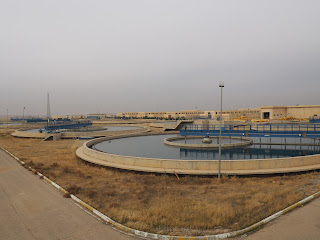This week I finally had the opportunity to visit a project we have recently completed - I have been trying to visit for some time, but other priorities always got in the way, so I was thrilled to get there this week.
Some months ago, as Mosul was being re-taken neighbourhood, by neighbourhood, the Directorate of Water (DoW) reached out to a number of agencies requesting assistance to repair water infrastructure throughout the district of Mosul. At DRC, we have built up quite an expertise in this particular area, and I have blogged before about other water infrastructure projects we have worked on. So when the DoW approached us we agreed to work on what is commonly known as the 'New Right Bank' (NRB) water project. This is a huge water treatment and pumping station on the outskirts of west Mosul, and is the second largest station in the country. During the time of ISIS, and their defeat, it was badly damaged and was left in complete disrepair, not functioning at all. This meant that residents in west Mosul and surrounding areas were not receiving any drinkable water from their taps. In the immediate aftermath of the fighting, residents in Mosul were heavily reliant on water trucks bringing drinkable water to their locations.
One of my teams is a Water, Sanitation and Hygiene (WASH) team - think lots of loveable geeks and engineers :-) This team is then split in two - one side works on the camp, ensuring residents have access to clean water, sanitation and hygiene items and knowledge all the time. The other side works on water infrastructure projects - they are experts in the engineering and mechanics of things like pumping stations. It is this team that took on the NRB project on behalf of the government. After weeks of cleaning, repairing, installing new parts, training new government staff; we were able to hand back to them a functioning water treatment plant that pumps out 12,000,000 litres of clean drinking water an hour, up to 22 hours a day, 365 days a year. This means that residents who are returning to re-build their homes in west Mosul and the surrounding areas can turn on their taps and drink the water without fear of disease. In a country where cholera is present, this is huge.
Before I went to see the project, I knew the scale from the meetings I'd been in and the reports from the team. But seeing it and having a tour from the government manager of the station was a whole different experience. It is a feat of engineering in an area where nothing has been left untouched by war. The buildings still have blown out windows, bullet marks, rocket holes. There still aren't enough staff as it takes so long to get security approvals for staff to work in a government facility due to the recent conflict, the whole perimeter still has to be guarded by the army to ensure it's not looted or worse, and there are still some further repairs needed. But to know that our investment, coupled with the expertise of our staff, has led to so many people having access to safe drinking water is phenomenal.
NB: there are some photos below. I have captioned them, but I may not have the technical terms perfect for everything as I am not an engineer :-) But the basic process goes - intake from the river, settlement tanks to take out large particles, fast mixer with first chlorination, filtration through various grades of sand, second chlorination, pumping out to the network. The water is then tested for chlorine levels several times a day using a rapid test and once a week using a full lab test. I don't have a photo of every stage I'm afraid.
 |
| Pumps to move drinking water out in to the network |
 |
| Control panel for the pumps |
 |
| Rapid mixing tanks (first chlorination) |
 |
| Most of the buildings are still damaged |
 |
| Filtration rooms (think massive biosand filters) |
 |
| Gas chlorination |
 |
| Gas chlorination |
 |
| Settlement tanks |
 |
| Settlement tanks |








